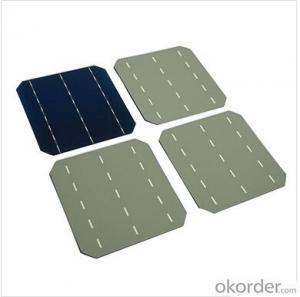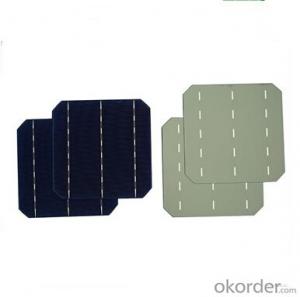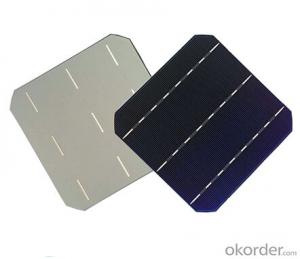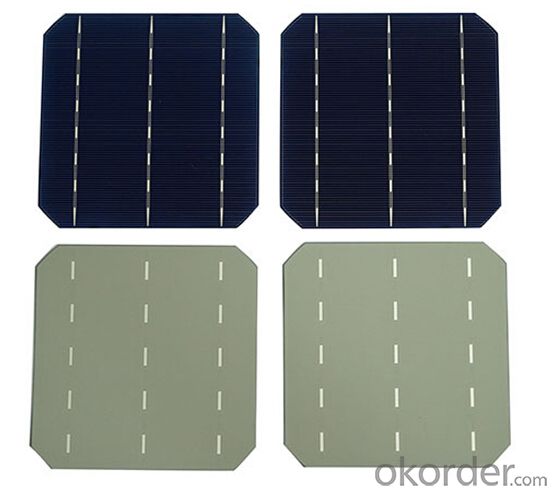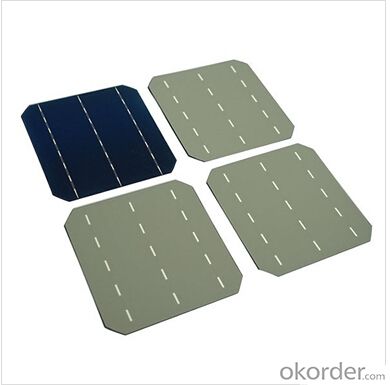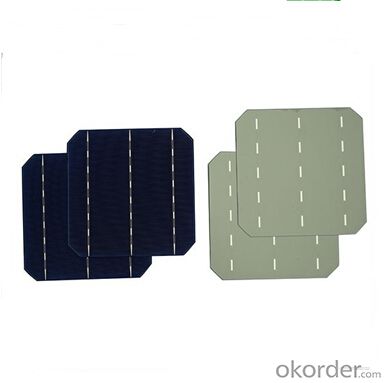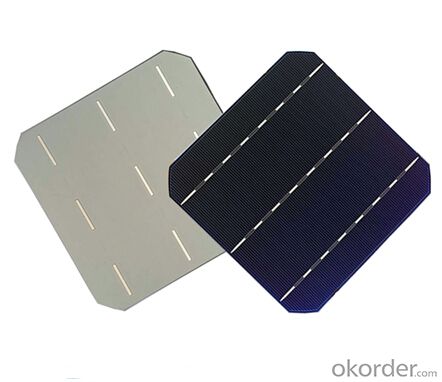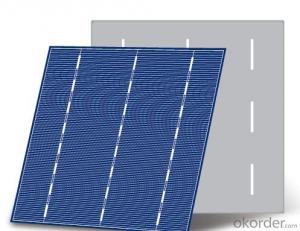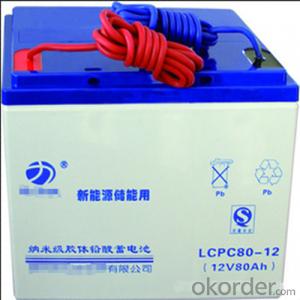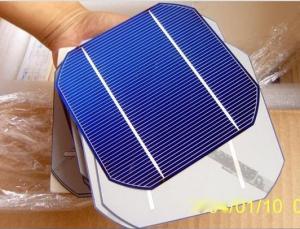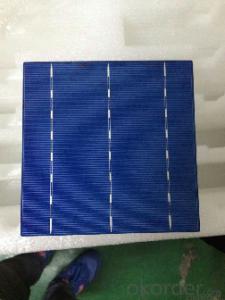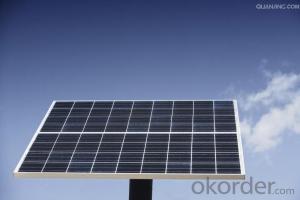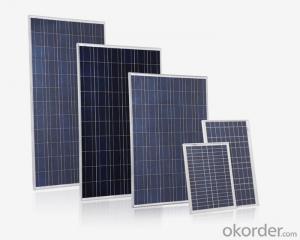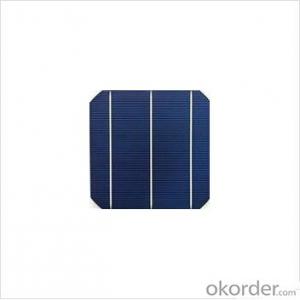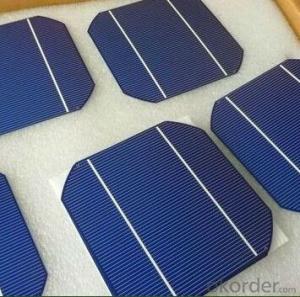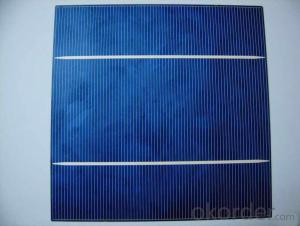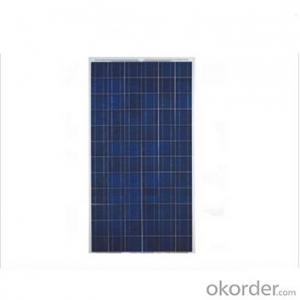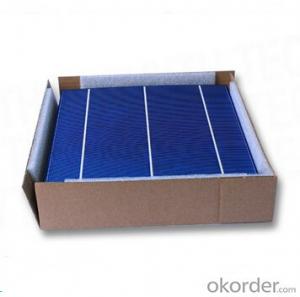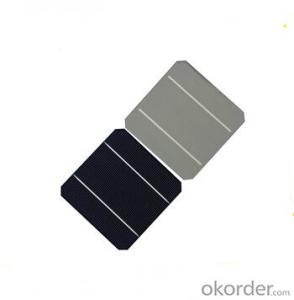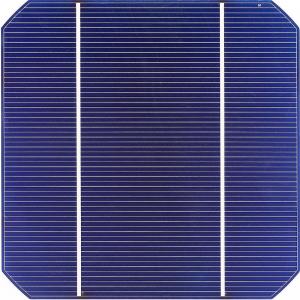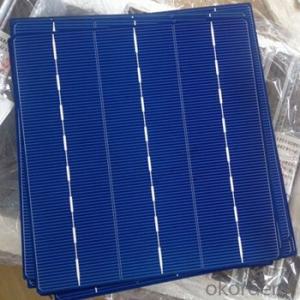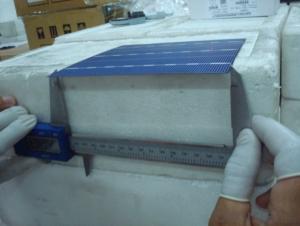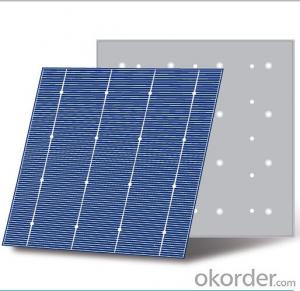Hexagonal A Grade Monocrystalline Solar Cells 17.4x17.6
- Loading Port:
- Shanghai
- Payment Terms:
- TT or LC
- Min Order Qty:
- 5000 pc
- Supply Capability:
- 80000 pc/month
OKorder Service Pledge
OKorder Financial Service
You Might Also Like
Monocrystalline Solar Cells A GRADE
Solar cells is made by solar wafer, it has three categories of solar cell right now, monocrystalline polycrystalline and thin film,These cells are entirely based around the concept of ap-n junction, which is the critical part of solar module, it is the part that can convert the light energy into electricity, the thickness is from 180um to 200um, with even busbars to conduct electricity, textured cell can decrease diffuse reflection; they are often electrically connected and encapsulated as a module. Photovoltaic modules often have a sheet of glass on the front (sun up) side, allowing light to pass while protecting semiconductor wafers from abrasion and impact due to wind-driven debris, rain, hail, etc. Solar cells are also usually connected in series in modules, creating an additive voltage. Connecting cells in parallel will yield a higher current;With high quality and stable quality. Our Cells can greatly improve the performance of Solar Modules.
Advantage of Monocrystalline Solar Cells
• High efficiency and stable performance in photovoltaic conversion.
• Advanced diffusion technique ensuring the homogeneity of energy conversion efficiency of the cell.
• Advanced PECVD film forming, providing a dark blue silicon nitride anti-reflection film of homogenous color and attractive appearance.
• High quality metal paste for back surface and electrode, ensuring good conductivity, high pulling strength and ease of soldering.
• High precision patterning using screen printing, ensuring accurate busbar location for ease with automatic soldering a laser cutting.
Specifications of Monocrystalline Solar Cells
Format : 156 mm × 156 mm ± 0.5 mm
Thickness: 210 μm ±40 μm
Front (-) : 1.5mm bus bars (silver),blue anti-reflection coating (silicon nitride)
Back (+) : 2.5mm wide soldering pads (silver) back surface field (aluminium)
Efficiency (%) Pmpp (W) Umpp (V) Impp (A) Uoc (V) Isc (A) |
18.20% 4.43 0.536 8.263 0.634 8.712 |
18.00% 4.38 0.535 - 8.188 0.633 8.701 |
17.80% - 4.33 0.534 - -8.112 ---0.632 ----8.652 |
17.60% 4.28 0.533 8.036 0.631 8.641 |
17.40% 4.23 0.529 8.005 0.630 8.591 |
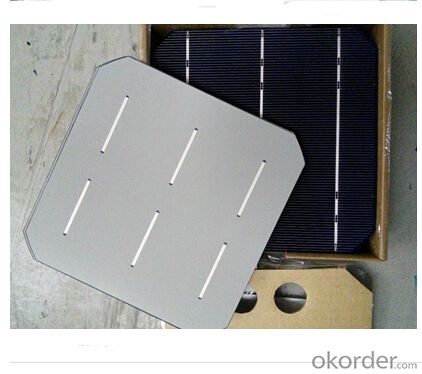
FAQ
We have organized several common questions for our clients,may help you sincerely:
①What price for each watt?
It depends on the efficiency of the solar cell, quantity, delivery date and payment terms.
②How long can we receive the product after purchase?
In the purchase of product within three working days, We will arrange the factory delivery as soon as possible. The pecific time of receiving is related to the state and position of customers.Commonly 7 to 10 working days can be served.
③Can you provide the peripheral products of the solar panels, such as the battery, controller, and inverter? If so, can you tell me how do they match each other?
Yes, we can, we have two companies for solar region, one is CNBM International, the other is CNBM engineering Co.
We can provide you not only the solar module but also the off grid solar system, we can also provide you service with on grid plant.
④What is your warranty of solar cell?
Our product can promise lower than 0.3% open box crack, we support claim after opening the box if it has crackm color difference or sth, the buyer should give pictures immediately, we can not accept the claim after the solar cell has assembled to solar panel.
• Timeliness of delivery
• ⑤How do you pack your products?
We have rich experience on how to pack the solar cell to make sure the safety on shipment, we could use wooden box or pallet as buyer's preference.
New Way of Making Solar Cells Promises Cheaper Power
A new way of making solar cells promises a cheaper way to generate electricity from the sun and new ways to integrate solar power into other products. When the light comes in and is both directly absorbed by the wires, and some of the light bounces around in between the wires. In fact, the absorption enhancement that we see is in the range of 20 to 50 times the single-pass absorbance. The principles with the wire arrays is grow them on a supporting substrate, and peel them off inside a plastic sheet, so that the material has exactly the optical and electrical properties of a silicon wafer, but instead it basically has the mechanical properties of a flexible plastic sheet. Except that, the flexibility opens the door to potential new applications. For example, the solar cell could be built into roofing material, saving money on installation. Other ideas for new uses come from the physical form of Atwater's novel design.
The more wonderful thing about solar energy is that it's accessible and available everywhere in the world, from the cloudiest place in northern Europe to the sunniest place in north-central Africa to the Outback of Australia to South Asia. And in fact the use of solar energy is growing worldwide for that reason."
To make the solar cells greener and more efficient, The scientists used the bacteria Mycobacterium smegmatis. In fact,A mycobacterium is a type of pathogen that can cause diseases such as tuberculosis, but the species scientists utilized in the study is harmless and can be found in soil and cornflakes. It also produces the protein MspA, which can be used for numerous applications once it has been chemically purified.
After purifying the protein, Scientist combines it with a synthesized dye that is less toxic than traditional dyes. The protein-dye mixture is coated onto individual solar cells and tested with artificial sunlight to measure energy output.
The core idea is that the protein acts as a matrix for electron transfer for this dye that absorbs sunlight. We want the protein to be able to capture the electron that the dye gives out and then transfer that electron in one direction, thereby generating an electrical current.
The new dye-sensitized solar cells do not currently improve on the technology’s ability to convert sunlight into electrical current, but they are the first of their kind and could help low-cost solar cells become a more viable option for alternative energy applications.
This type of research where you have a biodegradable or environmentally friendly component inside a solar cell has not been done before, and the research is still in its early stages right now. But we have noticed that it’s working, and that means that the protein is not decomposed in the light and electric generating conditions. Because of that, we believe that we’ve actually made the first protein-incorporated solar cell.
- Q: What is the maximum efficiency achievable by a solar cell?
- The maximum efficiency achievable by a solar cell is determined by the Shockley-Queisser limit, which states that the theoretical maximum efficiency is around 33.7% for a single-junction solar cell. However, in reality, due to factors such as material limitations and losses in the conversion process, the practical maximum efficiency of commercial solar cells currently ranges between 15% to 22%.
- Q: How do solar cells handle partial shading?
- Solar cells handle partial shading by using bypass diodes. These diodes allow the current to bypass the shaded area, ensuring that the rest of the solar cell continues to function efficiently. By redirecting the current, the solar cells can still generate power even if some parts are shaded, minimizing the impact of partial shading on overall performance.
- Q: How do solar cells impact air pollution?
- Solar cells have a significant positive impact on air pollution as they produce clean and renewable energy. By harnessing the power of the sun, solar cells reduce the need for fossil fuel combustion, which is a major source of air pollution. This means that the use of solar cells helps to decrease harmful emissions such as carbon dioxide, sulfur dioxide, and nitrogen oxides, leading to cleaner and healthier air.
- Q: Can solar cells be used for cooking?
- Yes, solar cells can be used for cooking. Solar cookers are designed to capture and convert sunlight into heat energy, which can then be used for cooking food. These cookers utilize solar cells to generate electricity, which can power electric stoves or ovens for cooking. Additionally, some solar cookers directly convert sunlight into heat using reflective surfaces and insulation, eliminating the need for electricity altogether.
- Q: How do solar cells perform in areas with high levels of electromagnetic interference?
- Solar cells may be affected by high levels of electromagnetic interference (EMI) in areas where strong electromagnetic fields or radio frequency signals are present. EMI can disrupt the normal functioning of solar cells, leading to reduced efficiency or even complete failure in extreme cases. To overcome this issue, it is important to employ proper shielding and grounding techniques to minimize the impact of EMI on solar cells. Additionally, advanced designs and technologies are constantly being developed to enhance the EMI tolerance of solar cells, ensuring their optimal performance even in areas with high levels of electromagnetic interference.
- Q: I would like to use a ppt to show how solar cells can work in a power generation factory, can anybody share some useful information with me?
- The idea behind solar cells is we basically using the free electricity from the sun.
- Q: Can solar cells be used in desert areas?
- Yes, solar cells can be used in desert areas. In fact, desert areas are considered to be ideal locations for solar energy production due to their high levels of solar radiation and clear skies. The abundance of sunlight allows solar cells to generate electricity efficiently, making them a suitable and sustainable energy solution for desert regions.
- Q: What is the role of solar cells in powering off-grid cabins?
- The role of solar cells in powering off-grid cabins is to harness energy from the sun and convert it into electricity. These cells, also known as photovoltaic cells, absorb sunlight and generate a direct current (DC), which is then converted into alternating current (AC) through an inverter. This AC power is used to operate appliances, lighting, and other electrical devices in off-grid cabins, providing a sustainable and renewable source of energy without the need for a traditional power grid connection.
- Q: Can solar cells be used in large-scale power plants?
- Yes, solar cells can be used in large-scale power plants. In fact, many countries are already utilizing solar power plants to generate electricity on a massive scale. These power plants consist of numerous solar panels or arrays that convert sunlight into electricity. With advancements in technology and decreasing costs, solar cells are becoming an increasingly viable option for large-scale power generation.
- Q: What is the lifespan of a solar cell battery?
- The lifespan of a solar cell battery can vary depending on various factors such as usage, quality, and maintenance. On average, a well-maintained solar cell battery can last anywhere from 5 to 25 years. However, advancements in technology and improvements in battery design are continually increasing the lifespan of solar cell batteries.
Send your message to us
Hexagonal A Grade Monocrystalline Solar Cells 17.4x17.6
- Loading Port:
- Shanghai
- Payment Terms:
- TT or LC
- Min Order Qty:
- 5000 pc
- Supply Capability:
- 80000 pc/month
OKorder Service Pledge
OKorder Financial Service
Similar products
Hot products
Hot Searches
Related keywords

